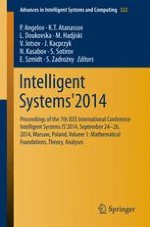This two volume set of books constitutes the proceedings of the 2014 7th IEEE International Conference Intelligent Systems (IS), or IEEE IS’2014 for short, held on September 24–26, 2014 in Warsaw, Poland. Moreover, it contains some selected papers from the collocated IWIFSGN'2014 ‐ Thirteenth International Workshop on Intuitionistic Fuzzy Sets and Generalized Nets. The conference was organized by theSystems Research Institute, Polish Academy of Sciences, Department IV of Engineering Sciences, Polish Academy of Sciences, and Industrial Institute of Automation and Measurements – PIAP. The papers included in the two proceedings volumes have been subject to a thorough review process by three highly qualified peer reviewers.Comments and suggestions from them have considerable helped improve the quality of the papers but also the division of the volumes into parts, and assignment of the papers to the best suited parts.
